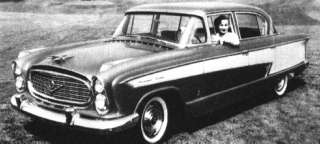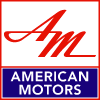The Start
At a time when, in Germany, the wheel was invented again in every other backyard, when doers like Paul Kleinschnittger with the F125 and Hans Glas with his Goggomobil motorized the western part of the nation, the small independent auto manufacturers of the United States were having major problems. The big disillusionment that caught Germany's scooter mobile makers soon and the small makers of bigger cars soon after was already making the independent auto companies fear about their further existence. The Big Three were just too mighty, and money was too short.
Nash (est. 1916) and Hudson (est. 1909) had to face the fact that things could not go on the way they had. Nash's president George Mason had first talked with Packard about a merger, but Packard had refused the offer. Instead they merged with Studebaker to form the Studebaker-Packard Corp. in 1954. The name Packard ceased to exist in 1959. Studebaker went out of business in 1966.
Mason started negotiations with Hudson's president Barrit, who didn't see any other solution to his company's money problems and agreed on a merger. On May 1st, 1954 the American Motors Coporation was founded.
One of the first actions to consolidate the new company was to end production of the technically dated and unpopular Hudsons. Hudson's factory in Detroit was shut down. The "new" Hudsons were modified Nashs, they were produced in Nash's factory in Kenosha, Wisconsin (near Lake Michigan, north of Chicago). George Mason passed away in October, 1954, and his assistant Romney took over. In the end of 1955 the plant in El Segundo, California was shut down. Production was moved completely to Kenosha. Despite this cost-cutting step, a loss was reported for 1955.
In 1956, American Motors launched the new Rambler that became its own make. Though it received cheers from the press, it could not hide the fact that AMC's fleet dated back to 1952 -- aeons in the fast-living USA. Although American Motors was able to report the 2,000,000th car built after Nash's sophisticated unibody concept, the year ended with: loss.

Nash Ambassador Custom, 1957
In the end of 1956 AMC presented its first self-constructed V8 engine which was put in the limited series Rambler Rebel. The Rambler sold well, but again in 1957 there was no gain.
The Fat Years
The Rambler got a new design in 1958 featuring stacked quad headlights. The names Nash and Hudson disappeared in favor of Ambassador by Rambler. The Ambassador was a restyled Rambler riding on a longer wheel base; it was top of the line from 1959 on and available with air suspension as an option. The performance oriented Rambler Rebel was still there, accompanied by the Metropolitan (offered since 1954), a sub compact car that was built by Austin in Great Britain for Nash, later AMC. The gap between the Met and the Rambler was filled by the Rambler American. The American was based on the vintage 1955 Rambler that got only slightly modified and was still powered by the dated side valve six cylinder engine. Recession made the economical Ramblers a good buy, and so 1958 was the first year of a net gain for AMC.

Rambler Ambassador, 1961
The following years were very successful. The fleet was kept the same with only slight changes, and AMC made good money. More than 422,000 Ramblers were sold in 1960, representing 6.4% of the whole market, the highest share AMC should ever reach.
© 1998-2010 Wolfgang A. Mederle. All rights reserved.
Last modified: 2019-12-25 16:17
